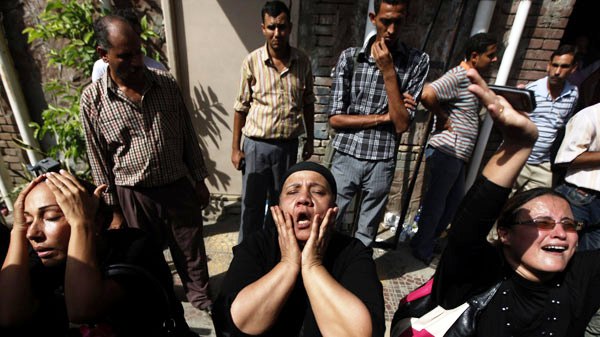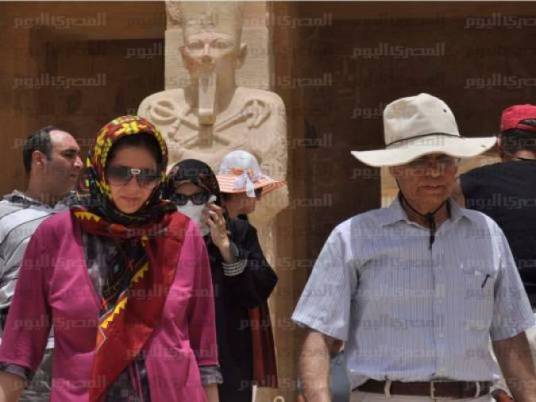Sixty years ago Hassan Fathy conceived of a village in Luxor that would inspire international architects and scholars. He used local materials and traditional knowledge with an ambitious idea to create a place that would provide new opportunities in work and life for the poor. He hoped this model would be replicated. Now his vision can be considered a failure; the buildings have collapsed, are crumbling or have seen new construction sprawl right on top of them.
Although Fathy’s dream was never fulfilled, the few remaining residents of what’s left of the collapsing village have dreams of their own. Writer Ahmed Youssef el-Jemel hopes to one day become a famous director. With pictures from the movie Titanic on his mobile phone and a fresh script in hand, el-Jemel wants to use the medium of theater to discuss social issues.
Inside a village that is falling apart, however, el-Jemel has few indicators that dreams can come true or that problems can be fixed. While giving a tour of the village, he expressed frustration as he marked the state of disrepair around him. A strip of buildings across from his two-room home was once the village khan, where craftmen produced their goods and trained apprentices. A large corner of the roof of its outdoor promenade has collapsed. The fallen mud bricks are still scattered on the ground beneath the gaping hole.
"This is very dangerous," el-Jemel says. "The people come from the government and they say they’re going to do something and they never do anything."
Residents say high-level government officials such as Prime Minister Ahmed Nazif and Supreme Council of Antiquities chief Zahi Hawass visited about a year ago and promised the residents the village would be renovated after decades of neglect. The residents might get their wish soon.
In early October the World Heritage Fund (WHF) released its yearly additions to the list of Endangered Sites, which included the mud-brick village in New Gourna conceived by Fathy. Hawass agrees with the WHF that the village has it concerns, but notes that "they [the WHF] can’t say [New Gourna is] endangered. The Supreme Council in Luxor is rebuilding it. We are doing a plan for the restoration." Several UNESCO officials are expected to visit the site in the coming months.
To describe Hassan Fathy’s village in Luxor as "endagered" is a gross understatement. Most of the few buildings left from this socio-architectural experiment of the 1940s have crumbling walls, broken windows, sloping foundations, collapsing roofs and are now part of a larger village that lies literally on top of the old structures. Were it not for the mosque, theater and the few remaining residents, Fathy’s dream of idyllic peasant architecture was abandoned when he died 20 years ago.
"There’s been no money since Hassan Fathy died," says Hussein Ahmed Youssef, or Abu Hagag, who lives in the village and holds the key to Fathy’s former house. "Everything is dead [because of] the government. They want to kill everything in Hassan Fathy."
Fathy spent most of his adult life dedicated to rural development. He saw the countryside as a paradise that had fallen to disease and contamination, "whose streams flowing underfoot had become muddy and infested with bilharzia and dysentery," he wrote in his book "Gourna: A Tale of Two Cities." He believed that if only given opportunity to live and work better, the rural poor would lift themselves up from poverty and sickness.
"My purpose was always to restore to the Gournis their heritage of vigorous locally-inspired building tradition, involving the active cooperation of informed clients and skilled craftsmen.” His idea, however, never really caught on with the residents. He wrote that many of the residents of Gourna did not want to move into his village in the first place and that most of them seemed disinterested in the building of the village. That many of the current villagers built additions to their homes with concrete and steel is a testament to the demise of Fathy’s hopes.
He also received opposition from the government and what one resident describes as "jealousy." In his book Fathy explained that he planned to open a craft school to teach the villagers skills such as carpet weaving to earn a living. He wrote a letter to what was then the Ministry of Commerce and Industry for permission to open the school. The director general wrote back that Fathy was trying to "force his ideas" on the ministry and that they wouldn’t be accepted.
“From his tone it seemed almost as if I was trying to take something from him instead of giving him something for free. Thus the weaving experiment died away, entirely through active governmental discouragement,” Fathy wrote.
Determined to train the villagers, Fathy designed an apprentice system to be implemented in the khan. Today the khan, which is falling apart, is used as government offices. During two visits by Al-Masry Al-Youm all of its doors were padlocked.
Fathy himself, however, is not without blame for the outcome. Since he was building in the 1940s, he took for granted that electricity and outdoor plumbing would become a standard amenity. As a result, the residents cut crude holes in the walls to feed electricity into their homes. Furthermore, ground water seepage is causing the foundations of buildings to slope, creating deep cracks in the walls. Fathy had chosen the site specifically because it was sheltered from ground water. "We settled upon a patch of agricultural land close by the main road and the railway line, low down in a hosha – a permanently dry field kept free from floodwater by a system of dikes," he wrote.
Fathy, who described the meticulous planning of the village in his many writings, never imagined that water could harm his village. He also did not want to believe that the residents would not accept the way of life he imagined, even though he wrote that they did not want to move there.
"Whether, when [the villager] has lived in a truly beautiful and dignified village, he will still be hankering after imported modernity, we shall have to wait and see," Fathy wrote. "Perhaps, when he has no reason to envy the rich man anything at all – his wealth, his culture, and his consequence – then too he will cease to envy him his house."
It probably was not envy that drove the residents to build with materials other than mud brick, but economics. Cement and steel are now much less expensive than they were 60 years ago, and provide a means to build several storeys, which saves the amount of land used.
A number of factors contributed to the demise of Fathy’s village, but maybe his vision was simply too idealistic. He hoped others would embrace his ideas, but few ever did. He thought the village could serve as a model for others and spread, but it has never been replicated. Despite this, Fathy remained an advocate of rural development until his dying days, clinging onto his dreams as he gazed at the countryside through train windows as a young man.
Like Fathy, el-Jemel is holding onto his own dreams. Although he hopes to be a famous director, he would be satisfied if his ideas help change some of the traditional behavior in the countryside of Upper Egypt. His play, Thaar (revenge), tackles the issue of honor killings between families that turn into a vicious cycle of violence. He is planning to show it in Cairo in February.
"When someone kills someone from another family they don’t call police, they kill someone from the other family," el-Jemel says, "I want to stop this because it’s wrong."




